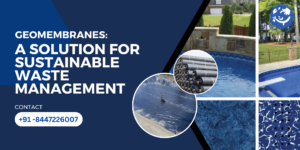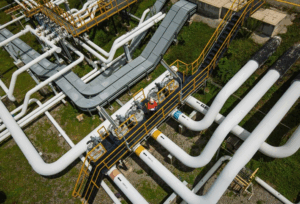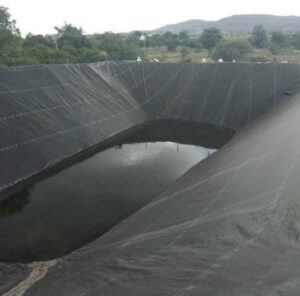Strengthening Railway Infrastructure with Geocell Technology: Ocean Non Wovens’ Role in the NWR Doubling Project, KTWS–NNL
Project Overview
The NWR (North Western Railway) Doubling Project, KTWS–NNL is a significant infrastructural development under Indian Railways, aimed at enhancing rail connectivity and optimizing logistics between Kathuwas (KTWS) and Narnaul (NNL) in Mahendragarh, Haryana. The project focuses on doubling the existing track to improve line capacity, reduce delays, and ensure better safety and speed for freight and passenger trains.
As a key contributor to the success of this project, Ocean Non Wovens played a pivotal role by supplying and installing 10,000 square meters of Geocell 660*75, a high-performance geosynthetic solution designed for superior ground reinforcement and soil stabilization.
Why the KTWS–NNL Doubling Project Needed Geocell Technology
Railway doubling projects face several geotechnical challenges, especially in regions with variable soil conditions and limited bearing capacity. The section between KTWS and NNL presented such challenges, where subgrade instability, soil erosion, and differential settlement were major concerns due to the alluvial nature of the terrain in Mahendragarh.
Traditionally, compacted granular fills or stone columns have been used, but these solutions can be cost-intensive and time-consuming. To tackle these issues effectively and economically, the project engineers opted for geocell-based reinforcement, a modern and sustainable solution widely adopted in transport infrastructure around the world.
Product Deployed: Geocell 660*75
The geocell supplied by Ocean Non Wovens was the Geocell 660*75, a three-dimensional, honeycomb-like structure made from high-density polyethylene (HDPE). This particular variant—660 mm cell diameter with 75 mm height—was selected for its optimal balance between confinement, drainage, and load distribution.
Key Features of Geocell 660*75:
- Cell Depth: 75 mm – ideal for moderate load-bearing applications like railway subgrades.
- Cell Width: 660 mm – ensures extensive soil confinement for long stretches.
- Material: UV-resistant HDPE – ensuring long life and minimal degradation.
- Load Distribution: Helps spread vertical loads laterally, reducing stress on subgrades.
- Erosion Resistance: Mitigates soil migration under vibration or water action.
This product was engineered to meet Indian Railway specifications and was subjected to rigorous quality testing before deployment.
Execution: Installation & Engineering Considerations
The installation of 10,000 SQM of Ocean Geocell 660*75 was carried out in multiple stages under tight deadlines due to the critical nature of rail infrastructure upgrades. Here’s how the work was approached:
- Subgrade Preparation: The native soil was graded and compacted to ensure a level foundation.
- Placement of Geocells: The geocells were expanded onsite and pinned using reinforced polymeric or metal stakes to hold them in place.
- Infill Material: Locally available granular material was used to infill the geocells, thereby reducing overall costs.
- Layer Compaction: Each layer was compacted using vibratory rollers to achieve the desired Proctor density.
- Top Layer Finishing: The final layer was capped with a ballast bed in accordance with the rail track design.
This geosynthetic intervention ensured a high load-bearing platform capable of withstanding the dynamic loads imposed by high-speed trains and heavy freight movement.
What Makes Geocell Ideal for Rail Infrastructure?
Most companies stop at describing the product, but let’s dig deeper into why Geocell is transforming the railway sector in India and globally:
- Reduction in Ballast Fouling: Studies show that geocell-reinforced sub-bases reduce the rate of ballast contamination, thereby extending the maintenance cycle (Source).
- Faster Installation Time: Compared to conventional stabilization methods, geocells reduce construction timelines by 20–30%.
- Lower Carbon Footprint: The use of local fill material within the geocell reduces the carbon emissions related to transporting engineered fill.
- Improved Drainage: Perforated geocells facilitate natural drainage, minimizing water logging—a common problem in railway embankments.
Project Outcomes
- Trackbed stabilization successfully achieved over 10,000 SQM.
- Reduced differential settlement, ensuring safety and longevity.
- Accelerated construction timelines, keeping the doubling project on schedule.
- Cost savings of 15–20% over traditional reinforcement methods.
- Long-term reduction in maintenance, offering lifecycle value.
The successful completion of this scope by Ocean Non Wovens showcases the potential of geosynthetics in modern rail infrastructure, particularly in regional rail networks like NWR that require scalable yet durable engineering solutions.
About Ocean Non Wovens – Your Partner in Geosynthetics Excellence
At Ocean Non Wovens, we don’t just supply geosynthetics—we engineer solutions. With over a decade of experience, we are one of India’s most trusted manufacturers and suppliers of HDPE geocells, geotextiles, geomembranes, geogrids, and other high-performance materials used in infrastructure development.
Our involvement in the NWR Doubling Project, KTWS–NNL, is just one example of how our products are shaping the future of India’s infrastructure. Whether it’s highways, railways, landfills, or erosion control—our team ensures timely delivery, technical expertise, and project-specific customization.
Ready to strengthen your next project with cutting-edge geosynthetics?
Let’s build sustainable infrastructure, together.
Contact us today to get expert consultation on your geotechnical challenges.



